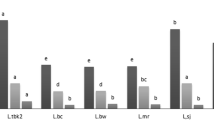Abstract
Mature seeds of four Lupinus species,L. albus, L. angustifolius, L. luteus andL. mutabilis, have been analysed comprehensively to evaluate their potential for nutrition. Particular interest attaches to the comparison betweenlupinus species and soyabeans.
All species are rich in high-quality protein, as judged from amino-acid profiles,In vitro studies indicate high levels of digestibility and imply the presence of few interfering factors. In contrast to many other legumes, lupinseeds are free of both protease inhibitors and haemagglutinins. Only one factor, a C-glycosyl poly-hydroxy flavone, which could conceivably interfere with protein absorption, has been identified.
Lupinseed could possibly be developed as an oilseed crop, though oil contents are currently somewhat lower than those of soyabeans. The composition of lupinseed oil is similar to that of soyabean oil, both being limited in quality by the presence of linolenic acid. The bright yellow colour of the partially refined oil is due to the presence of the two carotenoids, β-carotene and zeaxanthin.
Lupinseed is well-known to contain toxic alkaloids of the quinolizidine group. However, intensive breeding programmes involving all four named species have been in progress for many years. At least in the cases of the first three species, cultivars have been developed that are virtually alkaloid-free.
Alkaloid profiles are of interest in being decisive chemotaxonomic indicators of species. The pyrimidine bases responsible for inducing favism through the consumption ofVicia faba are absent from lupinseed.
Like soyabeans, lupinseed invariably contains a range of chemically complex saponins. Concentrations in the seed are of a similar order, but it is doubtful whether these should be considered significant anti-nutritional factors for Man.
Lupinseeds contain a range of oligosaccharides—raffinose, stachyose and verbascose —which correspond with the flatus factors present in soyabeans and many other legumes. Levels, however, are no higher than those found in soyabeans.
Zusammenfassung
Reife Samen von vier Lupinenarten,L. albus, L. angustifolius, L. luteus undL. mutabilis wurden zur Klassifizierung und Bewertung ihres ernährungsphysiologischen Potentials untersucht. Spezielles Interesse galt einem Vergleich zwischen Lupinenarten und Sojabohnen.
Alle Arten verfügen über ein Protein von hoher Qualität, was aus den Aminosäure-Spektren zu schliessen ist. Studien in vitro ergaben hohe Werte für die Verdaulichkeit und zeigten nur wenige störende Faktoren an. Im Gegensatz zu vielen anderen Leguminosen sind Lupinensamen frei von den beiden Protease-Inhibitoren und von Hämaglütininen. Nur ein Faktor, ein C-Glykosyl-Polyhydroxy-Flavon, das eventuell die Protein Absorbtion stören könnte, wurde identifiziert.
Lupinen könnten möglicherweise zu einer Ölsaatenkultur entwickelt werden, obwohl die Ölgehalte stets niedriger liegen als die von Sojabohnen. Die Zusammensetzung des Lupinensamen-Öls ähnelt der des Sojabohnen-Öls, die Qualität beider wird durch die Anwesenheit der Linolensäure limitiert. Die gelb scheinende Farbe des teilraffinierten Öls beruht auf dem Vorhandensein zweier Carotinoide, nämlich β-Carotin und Zeaxanthin.
Es ist gut bekannt, dass Lupinensamen toxische Alkaloide der Chinolizidin-Gruppe enthält. Jedoch lassen intensive Züchtungs-programme für alle vier Arten seit vielen Jahren Fortschritte erwarten.
Bei den ersten drei Arten sind Sorten gezüchtet worden, die nach heutiger Erkenntnis alkaloidfrei sind. Alkaloid-Spektren sind von Interesse, da sie entscheidende chemotaxonomische Indikatoren für die Arten darstellen. Die Pyrimidinbasen—verantwortlich für das Auftreten von Favismus durch Verzehr vonVicia faba—fehlen in Lupinen-Samen.
Wie Sojabohnen enthalten Lupinen stets eine Reihe chemisch komplexer Saponine. Die Gehalte im Samen betragen etwa die gleiche Höhe, aber es erscheint zweifelhaft, ob diese als signifikante antinutritive Faktoren für Menschen zu betrachten sind.
Lupinen-Samen verfügen über eine Reihe von Oligosacchariden—Raffinose, Stachyose und Verbascose—, die den Bläh-ungs-Faktoren bei Sojabohnen und vielen anderen Leguminosen entsprechen. Die Gehalte sind jedoch nicht höher, als bei Sojabohnen ermittelt.
Similar content being viewed by others
References
Hill, G.D.. 1977. ‘The composition and nutritive value of lupin seed’,Nutr. Abst. Rev. —Series, B, 47:511–527.
Hudson, B.J.F., Fleetwood, J.G., & Zand-Moghaddam, A., 1976. ‘Lupin: an arable food crop for temperate climates,’Plant Foods for Man, 2:81–90.
Author information
Authors and Affiliations
Rights and permissions
About this article
Cite this article
Hudson, B.J.F. The nutritional quality of Lupinseed. Plant Food Hum Nutr 29, 245–251 (1979). https://doi.org/10.1007/BF02590278
Issue Date:
DOI: https://doi.org/10.1007/BF02590278



